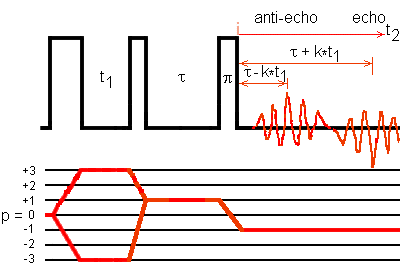
Amplitude-modulated shifted-echo pulse program
with 3 strong pulses for 3QMAS.
Contribution of R. Hajjar

Amplitude-modulated shifted-echo pulse program
with 3 strong pulses for 3QMAS.
Contribution of R. Hajjar

This amplitude-modulated shifted-echo pulse program is for (1D and 2D) 3Q-MAS experiment applied to quadrupolar nuclei with half-integer spin. The echo amplitude and the antiecho amplitude have opposite signs.
This NMR pulse program is for Bruker Avance spectrometers.
The hyper-complex acquisition mode looks simpler than that for ASX spectrometers. In fact, for 2D experiments, the macro instruction F1PH(ip1, *) generates the acquisition instructions automatically for the second half part of the data. In other words, the same pulse program is applied for the four half-integer quadrupole spins.
Strong pulses allow a better excitation of off-resonance spins.
The data processing could be performed with the RMN(fat) program for Macintosh provided by P. J. Grandinetti:
fecho(t1, t2) = Scos(t1, t2) + i*Ssin(t1, t2)
fanti-echo(t1, t2) = Scos(t1, t2) - i*Ssin(t1, t2) ;
fecho(t1, t2) = Scos(t1, t2) - i*Ssin(t1, t2)
fanti-echo(t1, t2) = Scos(t1, t2) + i*Ssin(t1, t2) .
After the Fourier transform with respect to t2, a tau-dependent first-order phase correction is performed to remove the phase modulation due to the shift and a t1-dependent first-order phase correction to perform the shearing transformation.
; RHmp3qShiftEandAE ; 3Q MAS pulse program for nuclei with half-integer quadrupole spin, ; amplitude-modulated shifted-echo, ; 3-strong pulse experiment with full echo acquisition: ; excitation(±3Q) - conversion(1Q) - tau - 180° - acquisition(-1Q), ;ns : 48*n ;d1 : recycle delay ;p1 : excitation pulse at pl11 ;p2 : conversion pulse at pl11 ;p4 : 180 degree pulse at pl11 ;cnst31 : MAS spin rate ;pl1 : = 120 db ;pl11 : power level ;d6 : to allow full echo to build up ;l1 : number of rotor cycles for whole echo ;d0 : = 3u or longer ;in0 : 1 rotor period for synchronised experiment ;td1 : number of t1-experiments ;FnMODE : States ;MC2 : States "d6=((1s*l1)/cnst31)-(p2/2)-(p4/2)" ; set the delay d6 according to l1 and cnst31 ; values by the spectrometer automatically, ze ; clear memory, new data replace old data, ; switch AD converter to replace mode, ; perform DS before next acquisition, 1 d1 ; recycle delay, 10u pl11:f1 ; 10 microsecond delay, ; set high power in f1 channel, (p1 ph1):f1 ; high-power excitation pulse, d0 ; delay between pulses, t1 increment, (p2 ph2):f1 ; high-power conversion pulse, d6 ; delay tau calculated automatically, (p4 ph3):f1 ; high-power 180° pulse, go=1 ph31 ; signal acquisition, ; loop to 1, NS times for averaging, d1 mc #0 to 1 F1PH(ip1, id0) ; delay for disk I/O, store signal, ; increase FID number, ; delete memory data, ; do not perform dummy scans ; with next acquisition, ; increment p1 pulse phases by 360°/12 for States procedure, ; increment time d0 by in0, exit ; end of the pulse program ph1=(12) 0 2 4 6 8 10 ; excitation pulse phase ph2= 0 ; conversion pulse phase ph3=(8) 0 0 0 0 0 0 1 1 1 1 1 1 2 2 2 2 2 2 3 3 3 3 3 3 4 4 4 4 4 4 5 5 5 5 5 5 6 6 6 6 6 6 7 7 7 7 7 7 ; 180° pulse phase ph0= 0 ph31= 0 2 0 2 0 2 1 3 1 3 1 3 2 0 2 0 2 0 3 1 3 1 3 1 ; receiver phase